August 31 - September 1, 2002
to prevent our family vacation from spoiling, we started our trip by immersing ourselves in salt
| Salt of the Earth August 31 - September 1, 2002 to prevent our family vacation from spoiling, we started our trip by immersing ourselves in salt |
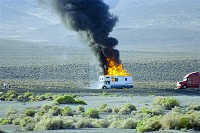 |
||
| Breaking up boredom of Nevada desert gawkers from left, truck driver from right -- it seems our presence would be redundant here |
Two years ago, we performed a great expedition over western USA. We did not know it then, but it actually was our (fore)honeymoon trip. After our wedding, there was no more time nor vacation left, and we had other worries to take care of. The following summer we, understandably, spent in Europe, while this year started under the influence of a hunt for our home. But suddenly we could not bear it anymore and had to make another "big trip". A plan had been ready for whole two years -- get to Glacier National Park in Montana, which we did not get to last time we were around.
It's quite a distance to travel, yet that never bothered either of us. Listening to music we did not time for during a whole year, eating, talking, stopping to take pictures, admiring landscapes, we simply enjoy a relaxing time, when we do not have to do anything in particular. I must mention that the first part of our route is always somewhat humdrum -- crowded freeways in Silicon Valley, industrial zones around Oakland, agriculturally flat Central Valley around Sacramento. But all that ends half day later, traffic fades away, and scenery happens around. State of Nevada consists mostly of deserts, and they in turn consist of dirt, hills, and stiff brush. I like Nevada a lot, despite mushrooming Las Vegas and Reno. Vegas feels like county fair that has been going out of control for several decades -- trumpery and arrogant neons covered by a smog lid in the middle of a desert. Reno looks nicer, but is more gray inside and full of burnt-out, rumpled characters. Reno was the city we were driving through this time, and we would not have stopped; however, my Hippo was in need of feeding -- and one can get wonderful noodle soups at a Vietnamese restaurant with formica tables in downtown Reno.
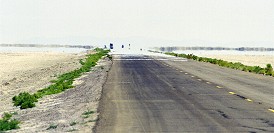 |
||
| Salty Mirage a warm air layer close to a hot ground makes this illusion of a quiet lake surface |
Refreshed, we continued through the desert across Carlin, NV. It was, unlike its recently flooded Prague namesake, quite dry there. A while later, smoke appeared on a horizon, we were expecting one of many wild fires that regularly plague western summers. Coming closer, we found a motorhome on fire. I don't know what may be the reason, but I get to see many more burning cars than I used to in Europe. As if they combusted spontaneously -- they're often not involved in any accident. This motorhome, too, was quietly parked on a shoulder and burned. Gawkers and other connoisseurs were generously represented, so we continued on without stopping, on to Elko, NV, where we found our lodging at a motel. Hippo had to suffer through the first of our many American food dinners to come (a choice of hamburger or steak).
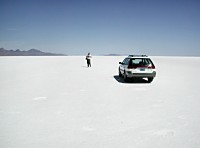 |
||
| Bonneville Salt Flats for scale please behold my Hippo and our Wagon |
On the second day, Nevada desert began to appear somewhat stereotypical even for me. Crossing a border to Utah, we were rewarded by a view to a white, seemingly snow plain. An ancient lake of Bonneville dried out over ages, leaving layers of salt behind. They dissolve each year again in winter precipitation and dry back into a salty crust. There's less salt on the rims, tough desert bushes grow there, but the salt plain in the middle of the "lake" is huge, absolutely flat, stone hard. The whole affair has 44 thousand acres and always attracted people. In winter and spring it turns into a dangerous sludgy trap, in summer then transforms into a blinding beauty, with a specious "mirage". The surface is cold to touch, but hot air above in forms a mirror -- mountains, cars, bushes -- they all seem to float on a glossy liquid surface. One cannot look at the salt without sunglasses; after some twenty minutes of staying outside our car I found the light had slightly scolded my face. Naturally we could not resist and drove out onto the racing track -- maintained by climate (yearly cycle of watering and smoothing down) and Bureau of Land Management (sweeping a wide band of white "road" which is marked with sprayed black lines). It officially measures ten miles long and eighty feet wide. The vast flat plain welcomed first racers in 1896 - with cars and bikes, a first automobile - Ferg Johnson's Packard - came in 1911. Records started being measured in 1914 -- Teddy Tetzlaff reached 141 mph on Blitzen Benz. In sixties there records reached six hundred miles an hour.
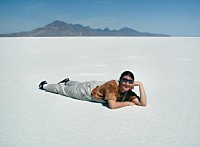 |
||
| Salted Carol to make a woman last in the desert, she ought to be well salted |
Indeed, any speed seems safe on a plain as wide and far as one can see. I must admit that all this volume of white material aroused some distrust in me -- I kept expecting this "ice" to cause us to slip. Regardless of that, or maybe because of it, this piece of strange landscape fascinates me. Hills floating in the distance, a complete uncomeliness of "snow" in a fiery desert, and the very vastness of the place, where other cars disappeared on a never-ending horizon, they all impressed me like a very odd dream.
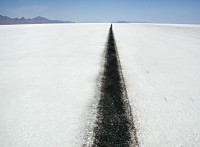 |
||
| Racing track a place to test horses under the hood (and own nerves) |
And it was not an end to all the salt. We returned to highway 80 and soon found ourselves in an infernally smelling reality. Utah's famous Salt Lake is home to bacteria that sometimes color its shores red -- and smell quite horribly. This very strong air used to be considered healthy -- to the point that Salt Lake City people had built a railroad going to air baths Saltair. A corny building looks derelict today, and is almost empty. Under huge domes, a few souvenir stands huddle next to a miserable refreshment booth for the few tourist that can't resist to explore the bygone luster. A muddy plain between the bath and water of the lake could not, however, lure us to a walk, after being to sparkling clean Bonneville. Salt Lake has no outlet -- water can only evaporate (while all the other things added by the large city nearby, stay in). Evaporation is not always enough for inrushing snowmelt waters in the spring and the lake used to overflow. Today, an elaborate system of pumps keeps the water level in check, moving excess water to another piece of desert, where it, ultimately, evaporates. That may be the reason for the muddy gap between the baths and the lake itself. This whole attraction made me feel depressed and sad, though.
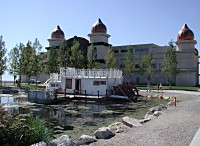 |
||
| Saltair slightly muddy, derelict fame of baths with a "strong air" |
We kind of looked forward to visit Salt Lake City, UT. Having expected some glamour remains of recent
Olympic games and a busy metropolis, we came to discover that we were being naive to seek that on the seventh
day of the week. It had escaped our attention that we were also visiting perhaps the most bigot Mormon town
in United States. And so we only coasted past closed stores and restaurants, which mentally turned me back some
twenty years and eastwards some six thousand miles, into our deep totalitarian past, with unmistakable Sunday
closedown of everything, tourist or not.
Californians spend most of their weekends shopping; here it obviously is to the church and then back home, procreating.
Well, don't think fun... we were passing by hundreds of sterile, arranged homes, empty playgrounds, vacated movie
theatres, closed coffeehouses, and hauntingly empty parking lots. Californians on a weekend open their garages wide,
take apart cars and dig in their yards, visit each other, talk on the streets, let kids loose in parks,
organize parties or neighborhood ball games, barbecue sausages, take no shame in living a leisure lifestyle,
don't hide their human failures and mess in their garages. Salt Lake City had the look of a Potemkin village.
All was pretty, orderly -- and completely inhuman.
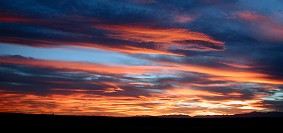 |
||
| Idaho sunset |
Besides, my Hippo growled angrily, for his feeding time came again and our icy, inhospitable surroundings did not offer much hope for a meal. We were saved by Fiesta Guadalajara in Layton, Mexican food, nice service, beer bottles displayed on a bar -- finally a piece of reasonable, sinful civilization! We skipped the beer, though -- we still had to cross Idaho and reach our destination: Montana.
Northern Utah and connecting part of Idaho are friendlier again, compared to the deserts. We saw rivers, grass, cattle, fields of grain and volcanic hills on a horizon. The landscape is not unlike Czech Central Mountains near Litomerice. We happily zipped through it and rushed to Montana, which welcomes every road tripper with almost unbelievable 75 mph speed limit. Our strength started to fade at Dillon, MT, but the whole town was sold out (due to a county fair with a rodeo). Population is not very dense in Montana (well it was in Dillon), and we had to swallow another seemingly endless sixty miles of wilderness to Butte. Fortunately for us, nothing of importance was happening there, and I fell to my bed making a resolution that we have to take advantage of this chance, which brought us to an interesting town like this. In the morning, that is.
Next: R rated - about romance novels, a mining town, and one extremely interesting museum.| Copyright © 2002-2005 by Carol & Sid Paral. All rights reserved. |